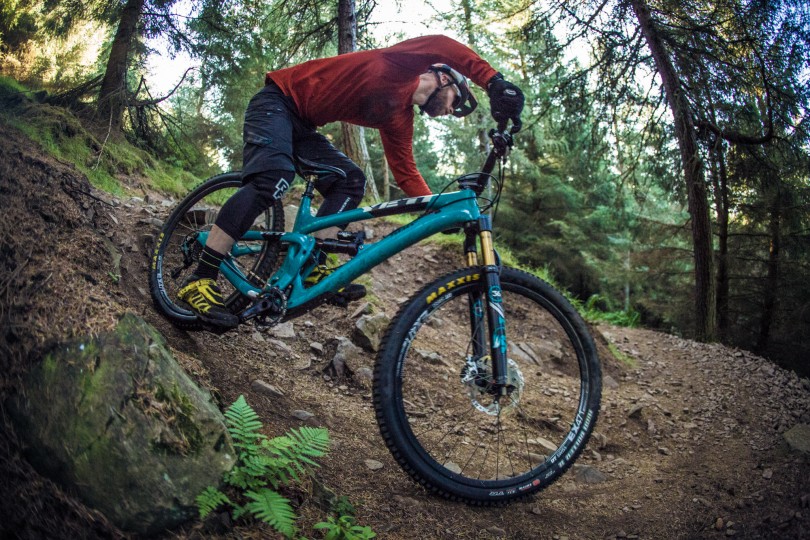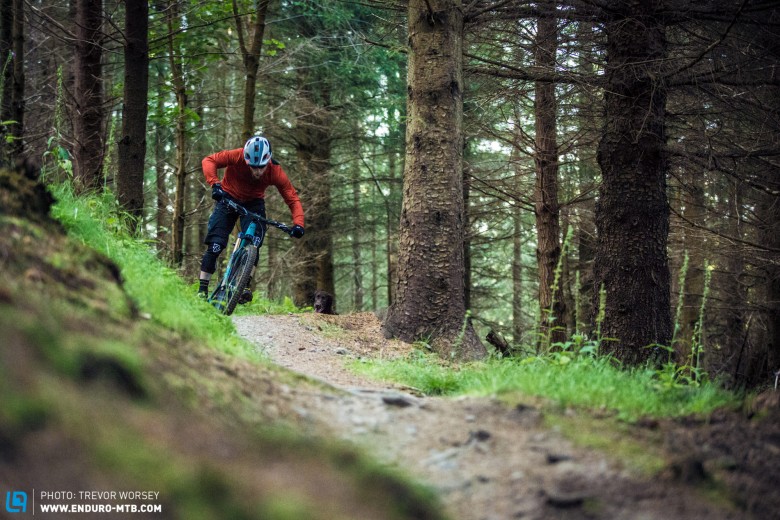ENDURO Long Term Test 2015 | Yeti SB6c 1000km Check Up

I was certainly the envy of the office when unboxing my turquoise Yeti SB6c and we all marvelled over the aggressive looks, repeatedly lifting it up to confirm the super light weight. You can find out my first ride impressions here, but after the 1000km milestone is the bike still performing as it should? And what about the Switch Infinity? Its time to check in and find out what it has been like living with the SB super bike.
We revisited the Yeti in September 2015 – check out our review of the SB6c.

Experience has shown that many ultralight ’boutique’ carbon frames suffer with thin and delicate paint, so I was pleased to see that after 1000km the bike still looks in great shape. The 12.8kg Yeti certainly qualifies as ultralight but hidden under those sculpted carbon tubes is a ‘rough and tough’ bike that sure can take a beating. The bike does now wear some deep scars from those exciting moments where confidence exceeds skill, but the paint has proven very durable and resilient. I was a little disappointed to see that rubber chainstay guard fell off within the first week, wrapping with cable ties would have prevented it’s unfortunate donation to the trail.

The heart of the new Yeti SB6c is the new Switch Infinity suspension platform, with the main pivot floating between two short Kashima rails. When you sit on the bike it drops into its sag and the pivot rises on the rails, as you work through the travel the pivot reverses back down the rails changing the suspension curve. This movement is only small but has a big impact on the leverage ratio, initially helping the bike keep supple and sensitive to small bumps while maintaining a supportive pedal platform, but then switching up on big impacts to ramp up through the stroke. The same can be said of most current bikes, but few work so smoothly and seamlessly as the Switch Infinity. The first time you hit big rocks at speed you hold your breath and grab the grips but the harsh impact never comes, just smooth composed damping. Even with the bike in ‘open mode’ the bike accelerates urgently when you stamp on the pedals and does not wallow or bleed away power.


I was initially really impressed with the FOX Float X shock running at 30%, but after a brief affair with an incredible PUSH ElevenSix Coil shock my eyes were opened to the untapped potential of the rear end of the SB6c. Fitting a Vorsprung Corset gave a very similar feel to the PUSH shock, the larger negative spring really improving the small bump performance. I did find that the Vorsprung requires a much higher pressure (up from 160 psi to 210 psi) and I still need to experiment a little to get the spring curve dialled, but the initial breakaway stiction is now ridiculously low, tap the seat with your little finger and the suspension reacts. I started out running 30% sag which felt great but have since moved to around 28% sag with a little less rebound damping, the bike still feels bottomless but feels a little more taut and playful under power. The suspension is now so frictionless through the stroke the addition of some volume spacers may be required to perfect the setup.


The FOX 36 RC2 fork has performed very well and a full strip down at 500km revealed no issues internally. For the higher speeds of the summer I fitted an extra Orange 10.8cc and Blue 7.6cc volume spacer (one blue was also fitted at the factory) to make the stroke more progressive, after 1000km the fork is as sensitive and accurate as the first ride. Running the fork with 20% sag seems to be the sweet spot for my style of riding.

Normally we find ourselves needing to change the bars and stems on test bikes, we have lost count of the number of bikes that come as standard with a huge stem and diminutive bars, so we were stoked to see the wide Easton Havoc carbon bar and Havoc 50 mm stem. Out of the box we liked the sweep and rise of the bars, but after repeated knuckle/tree meetings we cut the bars down to 770 mm. The supplied single clamp Yeti grips were a bit weedy for a bike with these aspirations and the grip body flexed at the ends. They were changed for some Hope Grips and the cockpit now feels a lot more positive. The neat Thomson dropper remote is not as easy to find as some of its rivals when at full gas, but is very compact and keeps the cockpit uncluttered.

The SB6c arrived at the start of a grimy Scottish winter, and I did not hold up much hope for the longevity of the drivetrain, but the SRAM X01 has soldiered on regardless. Over the last 8 months I have changed out the gear cable twice to keep the shifting sweet, and kept the chain clean and well lubed. Miss-shifts have been uncommon, but as with all 11 speed drivetrains, a little adjustment is needed here and there to keep the indexing crisp. I have also found on rare occasions in deep mud the lower jockey wheel has a tendency to jump out of the thick – thin orientation and clunk along happily out of alignment, but this may just be due to the special sticky mud of the Tweed Valley.



After 1000km a few maintenance issues are exected, and the Yeti SB6c has been no exception. At the close of winter I dropped the shock out for an air can service and was surprised to find that the rear suspension action was notchy and rough. After removing the switch link and separating the front triangle and swingarm I discovered that 4 of the F6902 LLU bearings were seized. Peeling back the dust covers and re-packing gave another week of life, but the damage had been done so I pushed them out for replacement. I was surprised to experience seized bearings at only 400km, but it had been a tough winter. The replacement set has covered 600km so far and still feel smooth. I did also note some cosmetic wear on the Switch Infinity Kashima coating, which I will keep an eye on. I must comment that the Yeti SB6c is one of the easiest bikes to strip down, the collet pivots are exceptionally easy to remove and everything simply screams quality. Removing the rear swing arm is a very simple five minute job and changing the bearings was a very simple process.

The DT Swiss wheels have been relatively problem free, the DT350 hubs have proven tough enough for a Scottish winter and the bearings still run fast and true, and the free hub still clicks away cleanly. The EX471 rims have a 25mm internal width which is wide enough to provide a good seat for most high volume tyres. I had to retension the rear wheel after a month of riding, but since then they have proven resistant to going out of true. The bike comes with Maxxis High Roller II EXO tires, a great choice for all round use. I swapped the tyres out early for some Maxxis Shorty’s for more bite in Scottish mud, but the High Rollers are back on now for the summer (is there ever a summer in Scotland?). The 25mm internal width of the rim let me run slightly lower pressures of around 22/24 psi while retaining sidewall stability. In fact the Yeti is SO good through the turns, it’s certainly a bike that would be interesting to run some 30 mm rims and lower pressures for unreal grip.

So what has it been like to ride? After 1000km the best way to describe the SB6c is “exceptional”. The sprightly feel of the low slung 28.5 lb bike means that it never feels like too much bike for the job, and I have raced it in dual slaloms, enduros and even a six hour endurance race. The suspension action is ridiculously good and notable in the way it changes through the stroke to give seamless bump absorption from small to large. I have lost count of the number of times I have charged blind into a direct line and waited for the chastising thump from the rear – that never comes. The Switch Infinity platform never hangs up on obstructions, keeping the bike pressing forwards is easy and forward momentum is always rapid. I have personally ridden faster on this bike than any other, just looking at my STRAVA account shows how confident this bikes makes me.

Geometry is king and in the corners the front/back balance is beautiful, flicking the rear wheel into a drift is insane fun and the bike has an agile and deft touch. The bike encourages an aggressive style weighting up the front end for maximum traction in high speed turns, and the light weight makes acceleration furious. It’s easy to get carried away on the Yeti, and often I have found myself hanging onto it as the bike does it’s best to keep me out of the trees.

We revisited the Yeti in September 2015 – check out our review of the SB6c.
So that’s the 1000km check in, aside from a bearing swap the Yeti has soldered on remarkably well and has made each and every ride a riot. We will be testing some exciting new products on the Yeti next month so keep an eye on the Long Term Test timeline for more news.
Words and photos: Trev Worsey
Did you enjoy this article? If so, we would be stoked if you decide to support us with a monthly contribution. By becoming a supporter of ENDURO, you will help secure a sustainable future for high-quality mountain bike journalism. Click here to learn more.








